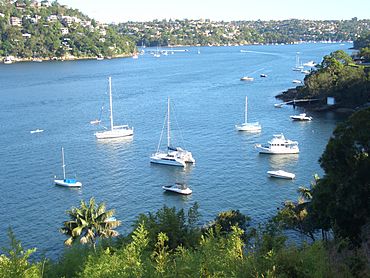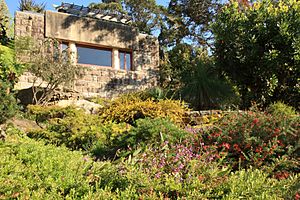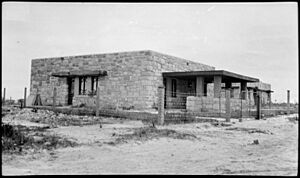Castlecrag, New South Wales facts for kids
Quick facts for kids CastlecragSydney, New South Wales |
|||||||||||||||
|---|---|---|---|---|---|---|---|---|---|---|---|---|---|---|---|

Middle Harbour, view from Castlecrag
|
|||||||||||||||
| Population | 2,965 (2021 census) | ||||||||||||||
| • Density | 1,772.5/km2 (4,591/sq mi) | ||||||||||||||
| Established | 1860s | ||||||||||||||
| Postcode(s) | 2068 | ||||||||||||||
| Elevation | 85 m (279 ft) | ||||||||||||||
| Area | 1.5 km2 (0.6 sq mi) | ||||||||||||||
| Location | 8 km (5 mi) north of Sydney CBD | ||||||||||||||
| LGA(s) | City of Willoughby | ||||||||||||||
| State electorate(s) | Willoughby | ||||||||||||||
| Federal Division(s) | North Sydney | ||||||||||||||
|
|||||||||||||||
Castlecrag is a suburb on the lower North Shore of Sydney, in New South Wales, Australia. It is about 8 kilometres north of the Sydney city centre. Castlecrag is part of the City of Willoughby local government area.
This suburb is very special because of its history. It is surrounded by Middle Harbour on three sides: north, east, and south. To the west, it is bordered by Eastern Valley Way. Castlecrag shares its postcode, 2068, with nearby suburbs like Willoughby and Middle Cove.
Contents
History of Castlecrag
Castlecrag was first planned by a talented husband and wife team, Walter Burley Griffin and Marion Mahony Griffin. They named the suburb after a tall rock cliff that looked over Middle Harbour, which was known as Edinburgh Castle. The Griffins moved to Castlecrag in 1925. They had become tired of the political issues they faced while designing Canberra, Australia's capital city.
Many of the first homes in Castlecrag were built using natural stone. This helped them blend in with the environment. This was a common idea in the Arts and Crafts Movement. This movement focused on creating things with a "human touch" instead of mass production. Other homes were built with bricks using Walter Burley Griffin's special Knitlock system. In the early 1900s, Castlecrag was known as a place that experimented with community planning and living.
The Castle Crag Post Office opened on 1 September 1937. It was later renamed Castlecrag in 1941.
Street Names and Community Spirit
The streets in the older, southern part of Castlecrag have names related to parts of a castle. These include The Barbette, The Barbican, The Bastion, and The Rampart. There are also reserves named Tower, Casement, and Turrett. The main street through the suburb is Edinburgh Road.
The Griffins wanted to create a strong sense of community in Castlecrag. They believed this could happen by encouraging people to interact and contribute. They planned many parks and recreational areas for everyone to enjoy. The Griffins lived in Castlecrag from 1925. They actively helped the community by planting native trees and improving the landscape.
Marion Mahony Griffin loved the arts. She helped create the Haven Scenic Amphitheatre. Plays and festivals were held there. Community spirit grew through groups like music clubs and the Neighbourhood Circle. Residents also helped each other build their homes.
The Haven Amphitheatre is currently being updated by Willoughby City Council. This project aims to make it a great performance venue again. Many groups are involved in this work. These include The Haven Amphitheatre Committee and The Walter Burley Griffin Society.
The Griffins' Vision for Nature
In 1921, Walter Burley Griffin (an architect and landscape designer) and Marion Mahony Griffin (an architect and artist) started designing Castlecrag. They wanted it to be a model suburb that respected Australia's natural environment. Walter Burley Griffin was amazed by the beauty of Sydney Harbour when he arrived in 1913. He believed that good planning should always respect the natural landscape.
The Griffins formed a company called the Greater Sydney Development Association (GSDA). This company bought and developed Castlecrag. Griffin was the main planner. His design for Castlecrag was carefully planned to fit the specific site. He disliked how Sydney's suburbs were laid out in simple grids. He felt they did not respect the environment. Both Griffins strongly believed that building new homes should not destroy nature. This idea was quite new at the time. It was influenced by the Garden city movement, which aimed to combine city and country living.
Planning for the Environment
The roads in Castlecrag were planned to follow the natural shape of the land. This was different from the usual grid patterns seen in many Sydney suburbs. It showed the Griffins' belief that buildings should respect nature. Trees along the roads were kept, and the roads were hard to see from above. The street layout also gave residents beautiful views of the landscape.
The architects designed special reserves linked by walking paths. This gave the community lots of space for recreation and bushwalking. It also kept the natural bushland look. The Griffins planned for 20% of Castlecrag's land to be parkland. This was much more than the 2% required by the Council.
Before Castlecrag was developed, the area's plants were being removed for firewood and soil. The Griffins encouraged respect for nature. They planted and protected native trees in public areas and gardens. They also set up rules called "covenants" for the land. These covenants limited how land could be used and what could be built. This helped protect the area's unique character. The rules stopped buildings from being too big, blocking views, or looking out of place. Today, governments and heritage groups work to protect Castlecrag's special environment.
Unique Architecture
In Castlecrag's early years, houses were designed or approved by the Griffins. About fifteen houses were built by them. These homes used concrete blocks and local stone. This made them blend with the natural surroundings. These materials also made building the houses quick and affordable. The Griffins' designs included clever ideas like kitchen pantries with pass-throughs and twin sinks. They also featured low-to-the-ground floors and large "picture windows."
Some parts of the Griffins' houses were quite unusual. This included the stonework, window details, and flat roofs. Flat roofs were preferred over sloped roofs. They did not block views and even allowed for rooftop gardens. Another unique feature was the location of kitchens and bathrooms. These rooms were often at the front of the house. Normally, they would be at the back. Living rooms were placed at the rear to face a view or park.
The Griffins' houses did not have front fences. Buildings were kept far back from property lines. Many houses were single-story and used natural colours. This showed the Griffins' goal: to have buildings blend into the environment. They wanted to keep the bushland setting. Their designs were very different from the common houses of the time, which often had red, sloped roofs.
Some newer buildings in Castlecrag have not followed the Griffins' original ideas. However, the Willoughby City Council knows how important Castlecrag is. They have put rules in place for new buildings. These rules help keep Castlecrag's special character. They encourage new buildings to respect the original designs and the natural landscape.
Transport
Castlecrag is served by the 203 and 275 bus routes. These buses connect the suburb to North Sydney and Chatswood. Busways operates these services.
Heritage listings

Castlecrag has several sites that are listed for their heritage value. This means they are important historical places. These include:
- 375 Edinburgh Road: Buhrich House II
- 8 The Barbette: Duncan House (Castlecrag)
- 80 The Bulwark: The Glass House (Castlecrag)
- 15 The Citadel: Fishwick House
Commercial area
The Quadrangle Shopping Village is on Edinburgh Road. It has an IGA supermarket and other specialty shops. There is also a small group of shops located across the street.
Population
| Historical population | ||
|---|---|---|
| Year | Pop. | ±% |
| 2001 | 2,643 | — |
| 2006 | 2,807 | +6.2% |
| 2011 | 2,957 | +5.3% |
| 2016 | 2,939 | −0.6% |
| 2021 | 2,965 | +0.9% |
The 2021 census found that 2,965 people lived in Castlecrag. Most people, 66.1%, were born in Australia. The next largest group, 5.9%, were born in England. About 78.9% of people spoke only English at home. Other languages included Mandarin, spoken by 4.3% of residents.
For religion, the most common answers were No Religion (43.0%), Catholic (22.5%), and Anglican (14.9%). The median weekly household income was $4,675. This is much higher than the Australian average of $1,746. Most homes in Castlecrag, 88.3%, were separate houses. Castlecrag is known as a wealthy area of Sydney.






